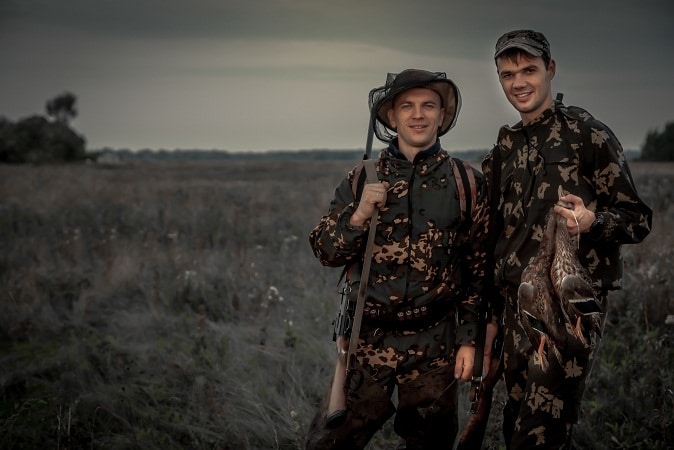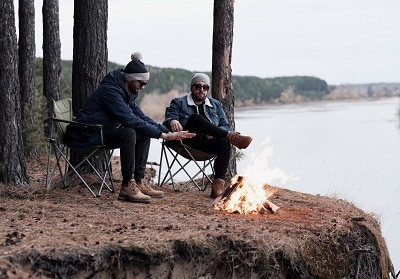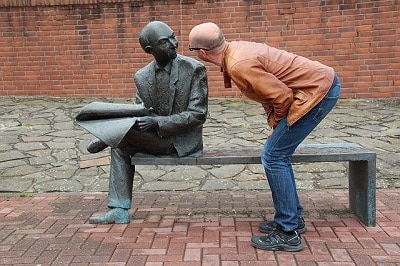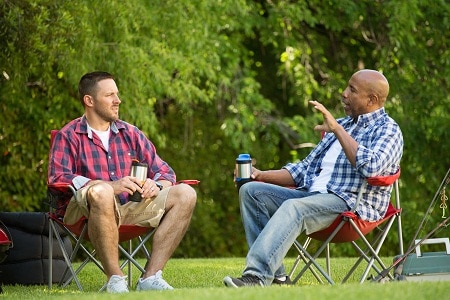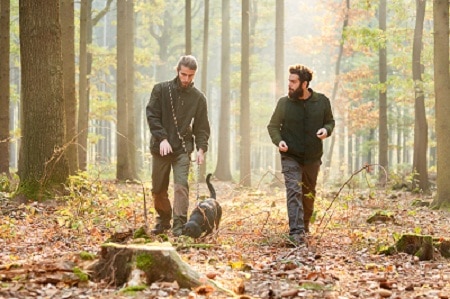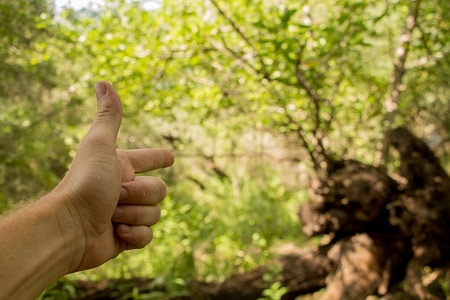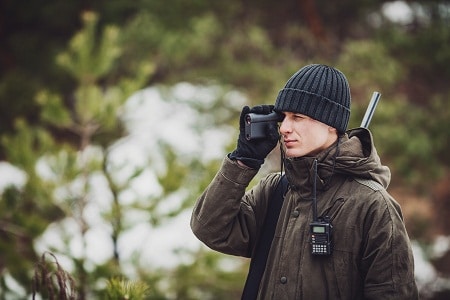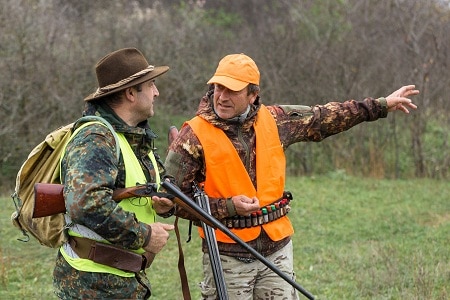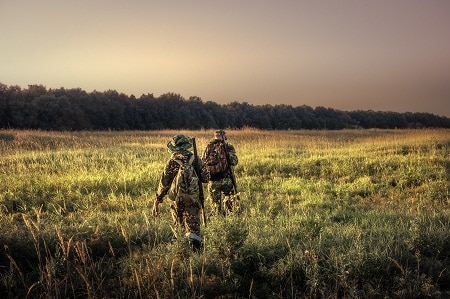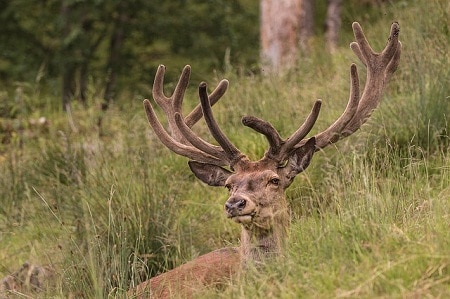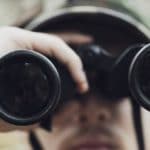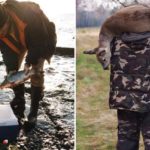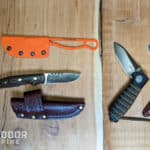Whether your target animal is bear, crow, coyote, deer, or squirrel, hunting is a challenging and satisfying activity.
Sometimes you can enjoy it solo. However, hunting with a partner is almost always better, even (especially?) if the two of you separate occasionally.
An extra set of eyes and ears allows you to spot game you would’ve missed, and an extra back can help you cart out the meat in fewer trips.
A partner can even keep an eye out for dangerous animals that might be interested in your freshly shot game.
However, a bad partnership experience can ruin your whole hunting trip and may even affect your friendship.
So, here’s some advice on hunting with a partner.
Before the Hunt
The most important parts of hunting with someone else happen before you even step foot in the wild.
There are six tasks you need to perform before your hunting trip begins. This may sound needlessly clinical, and you don’t need to treat this like a six-step-program, but if you don’t at least touch on these activities, then you won’t have a good time in the field.
The tasks are:
- Find a hunting partner.
- Evaluate experience.
- Lay down expectations.
- Scout together.
- Practice silent communication.
- Assemble gear.
Some of these are no-brainers, but we’ve all accidentally skipped obvious steps before.
1. Find a Hunting Partner
Before you can hunt with a partner, you need to have a partner to hunt with!
For some people, this is easy. Other people may find it terribly difficult.
If you have friends into hunting, they are an obvious choice. So are family members with experience. You can even try to convince someone to go hunting with you, but keep in mind the most important quality you need in a hunting partner: they have to want to hunt.
It doesn’t matter whether they are experienced, a good shot, or anything else. Hunting entails difficult travel through treacherous nature for long periods of time.
You want to have someone with you who wants to be there. A hunting partner who just wants to go home will drag you down and ruin the day for both of you.
Some people think they want to hunt but don’t have any aptitude for it. Don’t worry, you’ll find that out before the actual hunting trip if you follow along with the following steps.
If you don’t know anybody interested in hunting, there’s still hope for finding a hunting partner. You can find someone to hunt with you outside your social group. Who knows? They might become a friend, too.
Good places to find these people are at your local sporting goods store, at hunter’s safety courses, local hunting organizations, and even through online organizations such as HuntingBuddyFinder.com.
By the way, once you find a potential hunting partner, don’t just ask, “Hey, want to be my new hunting partner?”
Unless they were just bemoaning their lack of a hunting partner, that comes on too strong.
Instead, a more informal statement can pique their interest and softly present the possibility. Try something like, “I’m thinking of going deer hunting this upcoming season. Do you hunt deer, too?”
This can open a conversation that can lead to them becoming your new hunting partner.
2. Evaluate Experience and Skillset
Once you find a hunting partner, the two of you need to get on the same page about your skills, strengths, and weaknesses.
If you’re a veteran hunter, and they’ve only shot deer before, then dragging them into a three-day elk hunt with no preparation will not end well.
Similarly, following a more experienced hunter without letting them know you’re new will lead to disappointment.
Both of you should explain how much experience you have with all aspects of hunting, from hiking to shooting to cleaning.
An imbalance in skills can work well if the more experienced party agrees to mentor the other, and the other makes an effort to learn.
Teaching and learning are excellent ways of spreading our sport. Just don’t spring your inexperience on your friend!
Take Them Shooting
An excellent way to evaluate their experience is to take your prospective partner to the gun range and shoot some targets together.
Shooting practice is always fun, and this way you’ll be able to see if they handle guns safely.
You don’t want a hunting partner who full-on muzzle sweeps you!
3. Lay Down Expectations
Following this, the two of you should hammer out what you expect each other to do during the hunting trip.
- Who will be taking point?
- If you’re sharing a camping tent, who is carrying the tent?
- Who is going to cook the camp food?
If you’re hunting deer in bear country, it’s a good idea for one person to carry a deer rifle and the other a bear rifle. My hunting partner and I swap the two roles, but we set up the roles before our first hunt.
Also, this is the time to establish what animals you’re hunting, when you’re hunting, and how long your trip will take. Unless one of you loves or hates dressing animals (or is mentoring the other and agrees to teach this skill), a good expectation is: “you shot it, you dress it.”
Basically, lay out everything you want from the hunting trip and how to accomplish these goals. It’s okay if they’re not as passionate as you so long as you go into the hunt knowing you’ll be metaphorically carrying them.
4. Scout Together
Now that the theory is out of the way, it’s time to practice.
Some people love the idea of hunting but can’t handle the rigors of spending hours in the field with a gun and no internet.
You also need to scout out your hunting location to figure out where the deer are and where the good hunting spots will be. If you’re putting out trail cameras, bring them.
Scout with your partner and treat it as an unarmed practice run. You’ll be able to see if they are as experienced as they claimed and if they can handle nature’s unpleasantness.
This is half practice, half evaluation.
Related: What Do Hunters Hunt the Most? (Most Hunted Game Animals in the US)
5. Practice Silent Communication
I messed up my first hunting trip.
A teenager with a military surplus bolt-action rifle in hand and very little hunting experience in my brain, I was crossing a field with my father—me to one side and him to the other. He saw a deer and figured he’d swing around and send it my way. I didn’t see it.
I did, however, see him start to move faster, so I sped up to keep pace with him. He waved at me to stop me, but it looked like he was encouraging me to follow.
See the problem?
We hadn’t practiced communication and therefore had no way to tell each other what we were planning. We didn’t have any radios, and even if we had, using them would have spooked the deer.
So, while you’re in the woods (or uplands, or wherever), practice communicating with your partner without words. This means hand signals. You can make up your own or find the commands used by SWAT members or the military.
It’ll start off challenging, but by the time you’re hunting, you need to be able to give and receive commands without making a noise.
6. Put Together Gear
This last task is easy, but it’s a necessity.
Check over all the equipment, permits, and licenses you need for a successful hunt, and ensure both of you have what you need.
It’s easy to miss something obvious when left to your own devices, so if both of you double check what you need to bring, your chances of leaving something vital behind practically disappear.
It’s a good idea for both of you to have two-way radios so you can communicate when out of sight or during an emergency.
Bonus: Hunt Small Game
If you have time, it’s a good idea to practice partnered hunting on small game rather than jumping into a multi-day big-game hunt.
Rabbit hunting and upland game bird hunting are both perfect introductory hunts where you won’t be stressed out but can still practice silent communication and other hunting skills.
7. During the Hunt
By the time you and your partner go into the field for real, the two of you should know how to act as a team.
There are still some things you need to keep in mind.
The first is safety.
Always pay attention to your gun’s muzzle, and never let it aim anywhere near your hunting partner. Always keep your partner’s position relative to you in mind.
Safety also means not letting your partner fall too far behind you if you’re traveling in front and making sure your partner stay hydrated. It’s easy to forget to drink during a hunt.
There are two methods of traveling toward a hunting spot: fast and noisy or slow stalking. In either case, you can be close to each other or spread apart within line-of-site. Moving separately is slower but increases your chances of spotting game.
If you spot a game animal, stop moving immediately. You shouldn’t need to wave a hand signal to inform your partner of this fact. Any sudden stop by either of you should mean “Deer!”
Unless you hashed this out earlier, the first person to spot an animal has “dibs” on shooting it. Though, you should have a hand signal to communicate “This one’s yours.”
Once you’ve reached your hunting blind or stand, you can either stay together. Staying together lets you cover two different angles and typically works better in a hunting blind. Separating lets the two of you cover more area and also gives you an opportunity to radio your partner and inform them of incoming deer.
Don’t chatter too much over the radio if your partner is out of sight; they may have just spotted a buck and your squawking might scare it off!
Finally, if you hear a gunshot from your partner’s direction, don’t radio immediately. Give them time. Though most animals will generally run from a shot, some spooked animals may return to an area after the initial panic. This lets your partner take a second shot at a second animal…
…unless you spooked it off by radioing them.
Let them radio you first.
Even if they’re using an earbud with their radio. You don’t want to accidentally distract them at a critical moment.
Bonus: Deer Can’t Count
Did you know that deer are unable to count how many people are in a group?
“How is that even relevant?” you may ask.
One of the dirtier deer-hunting tricks I’ve learned is to take advantage of this fact. Talk loudly with your partner when you’re walking through an area with deer. The deer will hide.
Leave one of you there while the other one continues talking. The deer will think the group as a whole has continued on and become less cautious, potentially giving the hunter who stayed behind an excellent shot!
After the Hunt
After you’ve taken to the wilds, shot your animal (or not), and returned home, there are still one or two things to do with your partner.
You should celebrate the experience together. Even if you didn’t shoot anything! A trip through nature should always be invigorating or at least give you an appreciation for air conditioning and a sturdy roof.
Perhaps you can invite them over for a few beers.
And, if you shot an animal, be sure to share your bounty with them!
Conclusion
Hunting with a partner provides many advantages, including:
- Safety in numbers
- Additional senses for finding deer
- The camaraderie of time spent in nature together
The two of you can have wildly different skillsets, but as long as you and your partner know what to expect from each other and can work well together, hunting with a partner will only make your hunting trip better.
Something fun: 10 Best Hunting Shows on TV and Streaming (Where To Watch)

